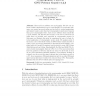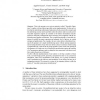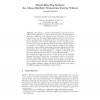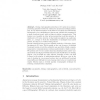EUROCRYPT
2004
Springer
14 years 5 months ago
2004
Springer
EUROCRYPT
2004
Springer
14 years 5 months ago
2004
Springer
For the last two decades the notion and implementations of proxy signatures have been used to allow transfer of digital signing power within some context (in order to enable flexi...
EUROCRYPT
2004
Springer
14 years 5 months ago
2004
Springer
An aggregate signature scheme (recently proposed by Boneh, Gentry, Lynn, and Shacham) is a method for combining n signatures from n different signers on n different messages int...
EUROCRYPT
2004
Springer
14 years 5 months ago
2004
Springer
Informally, an obfuscator O is an efficient, probabilistic “compiler” that transforms a program P into a new program O(P) with the same functionality as P, but such that O(P)...
EUROCRYPT
2004
Springer
14 years 5 months ago
2004
Springer
Denoting by P = [k]G the elliptic-curve double-and-add multiplication of a public base point G by a secret k, we show that allowing an adversary access to the projective representa...
EUROCRYPT
2004
Springer
14 years 5 months ago
2004
Springer
In trying to provide formal evidence that composition has security increasing properties, we ask if the composition of non-adaptively secure permutation generators necessarily pro...
EUROCRYPT
2004
Springer
14 years 5 months ago
2004
Springer
We revisit the following open problem in information-theoretic cryptography: Does the communication complexity of unconditionally secure computation depend on the computational com...
EUROCRYPT
2004
Springer
14 years 5 months ago
2004
Springer
Abstract. This work presents a new privacy primitive called “Traceable Signatures”, together with an efficient provably secure implementation. To this end, we develop the unde...
EUROCRYPT
2004
Springer
14 years 5 months ago
2004
Springer
EUROCRYPT
2004
Springer
14 years 5 months ago
2004
Springer
Abstract. Dining cryptographers networks (or DC-nets) are a privacypreserving primitive devised by Chaum for anonymous message publication. A very attractive feature of the basic D...







